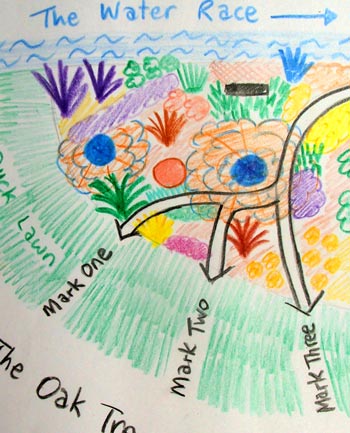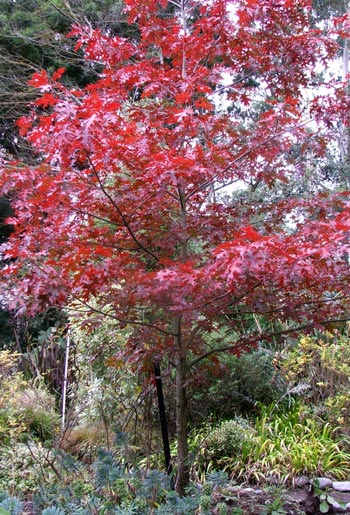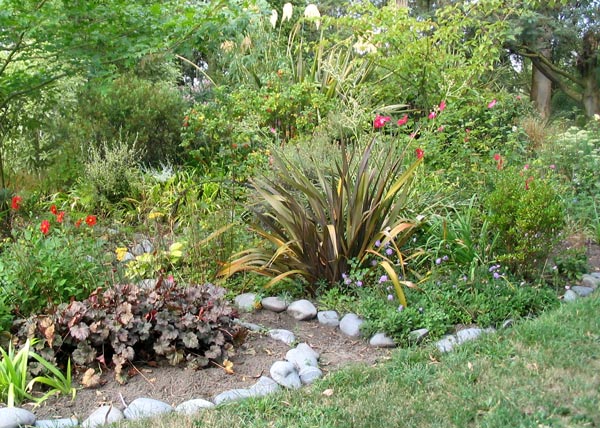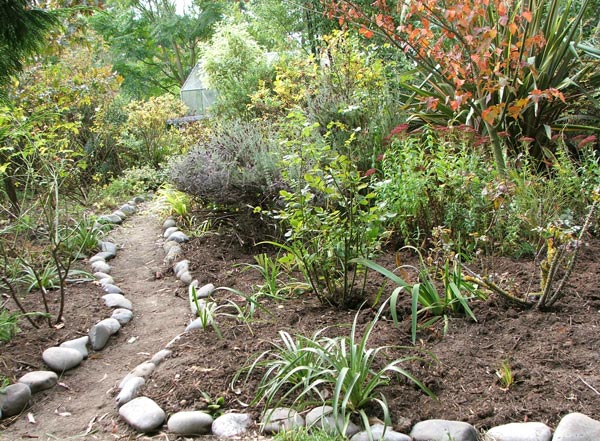The Oak Tree Path

Three Paths - The Garden Plan
The Oak Tree Path gives the middle of the large sprawling Hen House Garden shape and a sense of form. It connects the path by the water race to Duck Lawn, passing underneath a scarlet Oak tree. But there have been four different versions in ten years...
Early Days
The Oak Tree Path Mark One was 'constructed' - a word which implies rather more than any of my paths deserve - in the year 2001. It was a narrow thoroughfare from the water race out onto Duck Lawn, turning a ninety degree angle underneath the juvenile Scarlet Oak, passing the old gum tree stump, and squeezing through a mass planting (more accurately a mass self-seeding) of Euphorbias.
Originally this garden was pathless, and contained a scruffy Cotoneaster and various filler plantings (a one dollar shrubby lilac Lavatera, a one dollar Genista and some budget Lavenders). The new path divided the area into two, conveniently separating the New Zealand native evergreens from the British plants (though a rogue red Phormium did cross the line).
It was important to be able to take a short cut through the garden to the water. And I had misty visions of swathes of bluebells for the path to pass through...

The Scarlet Oak Tree
Beware of Cute Little Flaxes
The entrance to Duck Lawn (or exit, depending on one's travel plans) was punctuated on one side with the cutest little native grass, and on the other with the cutest little green flax. What happened then was quite simple, really - the cutest little native grass bulked out, and acquired sharp cutting edges, and the cutest little green flax grew... and grew... and grew...
The Second Path
The Oak Tree Path Mark Two was even more mathematical in design, as the path was re-routed in the summer of 2004. There were now two right angles, and the path pushed its way between a big bronze flax and a cluster of John Clare roses. Its point of emergence on Duck Lawn was now free of cute green plants with sharp edges - just wine coloured Heucheras and Irises on one side, and blue flowering perennial Scabiosa on the other.
There were problems, though. Daft clumps of spring bulbs popped up in the middle of the path, and extraordinary balance was required (on top of small shuffling footsteps) to stay on track.
The David Austin rose John Clare is a lovely rose - but not to wobble into, or fall on top of. And a rather spiky green foliage plant called Eryngium yuccifolium had taken up residence, liked what it found, and was busily self-seeding.

The Oak Tree Path Mark Two - Summer 2005
The Third Path
At the start of the very un-newsworthy Hen House Garden make-over in autumn 2005 it was obvious that the current Oak Tree Path was too small and too silly. The Oak Tree Path Mark Three was created easily (mentally, anyway) in a moment of extreme hands-on-with-dirty-fingernails gardening.
So Sensible
So sensible, really - it's almost straight, connecting the Pittosporums by the water to Duck Lawn. Finally, common travel-sense has prevailed. John Clare in particular is really grateful. Why didn't I think of this path route before? Now I can walk wobble-free, and there's even room for the wheelbarrow.

The Oak Tree Path Mark Three
Finally in autumn 2005 the Oak Tree Path in the Hen House Gardens gets its third and final modification - with just a little bit of plant shifting. Hopefully I've now got 'it' right!
But...
Now if you think this is the end of the story, then think again. I just didn't like the new almost straight shape. So in 2009 I went back to the very first path route, but I widened it, ruthlessly replanting anything that got in the way. Several Pittosporums near the water even got the chop down to ground level. It's possible to do a wheelbarrow wiggle around the Oak tree and not fall into the mass planting of spiky Eryngium yuccifolium... John Clare has moved out, the Oak tree has been limbed up, and the bluebells (I had to dig and shift many clumps) are still a joy in spring.
Technical Footnote
The Oak Tree Path has river stone edges with garden dirt in between. Thus re-routing it is quick and easy - an instant new path can appear in a matter of hours. With a few cosmetic edge plantings the illusion of permanence can be created in an afternoon!